|
|
|
|
|
|
 Official name: ПМР (PMR). This abbrevation stands for
Приднестровская
Молдавская
Республика
(Pridnjestrovskaya Moldavskaya Respublika - Predniestrian-Moldovan Republic). But this name is rarely used outside the PMR - most people refer to
it as Transdniestr. Officials of the PMR don't like that name: 'Trans' originally means 'behind'. They prefer 'in front of', which
means 'pri-' in Russian. Besides 'Transdniestr', many spellings are common: Transdnjestria, Transnestria, Transdnistria and so on.
The official English name, prefered by local authorities, is Dniester Moldavian Republic (DMR). The coat of arms also
contains the abbrevation PMH - this might be the Moldovan (ie Romanian) abbrevation, but I'm not sure.
Area: Curiously enough, PMR officials give different numbers:
According to the National Bank, the country covers 3,567 km², according to the
foreign ministery it's 4,163 km². As big as Rhode Island so to say.
Transdniestr covers 1/8 of the overall area of →Republic of Moldova.
Population: about 630,000, the netto growth rate is negative.
The population density is 160 inhabitants per km², which is one of the highest in the
former Soviet Union.
Ethnic groups: The claim that Transdniestr is a state of Slavic minorities is
not really true - the largest ethnic group turns out to be Moldovans - their share is 33.8%.
Ukrainians as well as Russians are 28.8% each. There are other minorities such as
Bulgarians, Gagauz (see →Comrat), Jewish and others.
Religion: If not atheistic, mostly Christian-Orthodox with
very few exceptions.
Time zone: Eastern European time: GMT +02 hrs, with daylight-saving time (+1 hour) in summer.
Language: De jure, the official language has to correspond with the share of
ethnic groups. Which means that there are three official languages:
→Moldovan,
→Ukrainian and Russian.
De facto, all you will see is Russian. Everything is in Russian, including
menus, signposts, timetables and so on. English is not really helpful. It's definitely a very good idea
to bring some Russian when you travel around. Anyway, the people are usually very nice, so
it's not dramatic if you can't speak Russian (at least this was our impression - although I speak some Russian).
Moldovan, if used, is written in Cyrillic script - as it was in Soviet Union times.
Official name: ПМР (PMR). This abbrevation stands for
Приднестровская
Молдавская
Республика
(Pridnjestrovskaya Moldavskaya Respublika - Predniestrian-Moldovan Republic). But this name is rarely used outside the PMR - most people refer to
it as Transdniestr. Officials of the PMR don't like that name: 'Trans' originally means 'behind'. They prefer 'in front of', which
means 'pri-' in Russian. Besides 'Transdniestr', many spellings are common: Transdnjestria, Transnestria, Transdnistria and so on.
The official English name, prefered by local authorities, is Dniester Moldavian Republic (DMR). The coat of arms also
contains the abbrevation PMH - this might be the Moldovan (ie Romanian) abbrevation, but I'm not sure.
Area: Curiously enough, PMR officials give different numbers:
According to the National Bank, the country covers 3,567 km², according to the
foreign ministery it's 4,163 km². As big as Rhode Island so to say.
Transdniestr covers 1/8 of the overall area of →Republic of Moldova.
Population: about 630,000, the netto growth rate is negative.
The population density is 160 inhabitants per km², which is one of the highest in the
former Soviet Union.
Ethnic groups: The claim that Transdniestr is a state of Slavic minorities is
not really true - the largest ethnic group turns out to be Moldovans - their share is 33.8%.
Ukrainians as well as Russians are 28.8% each. There are other minorities such as
Bulgarians, Gagauz (see →Comrat), Jewish and others.
Religion: If not atheistic, mostly Christian-Orthodox with
very few exceptions.
Time zone: Eastern European time: GMT +02 hrs, with daylight-saving time (+1 hour) in summer.
Language: De jure, the official language has to correspond with the share of
ethnic groups. Which means that there are three official languages:
→Moldovan,
→Ukrainian and Russian.
De facto, all you will see is Russian. Everything is in Russian, including
menus, signposts, timetables and so on. English is not really helpful. It's definitely a very good idea
to bring some Russian when you travel around. Anyway, the people are usually very nice, so
it's not dramatic if you can't speak Russian (at least this was our impression - although I speak some Russian).
Moldovan, if used, is written in Cyrillic script - as it was in Soviet Union times.
|
|
|
|
|
|
|
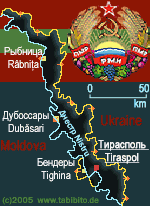 From north to south, the country is more than 200 kilometres long - however, the
average east-west extent is 20 kilometres only. At some points, it's only 4 km from the eastern to the western border.
To the west, Transdniestr borders the →Republic of Moldova.
Most of the border is marked by the river Nistru (Dniestr). Almost all of the territory
lies on the eastern bank of the river - except for two pockets, namely the area south of the capital →Tiraspol
and a small area around the town of →Bendery (Tighina), which was subdued
by the PMR after heavy fights.
From north to south, the country is more than 200 kilometres long - however, the
average east-west extent is 20 kilometres only. At some points, it's only 4 km from the eastern to the western border.
To the west, Transdniestr borders the →Republic of Moldova.
Most of the border is marked by the river Nistru (Dniestr). Almost all of the territory
lies on the eastern bank of the river - except for two pockets, namely the area south of the capital →Tiraspol
and a small area around the town of →Bendery (Tighina), which was subdued
by the PMR after heavy fights.
The area north of Dubăsari is rather hilly, the rest of the country is just flat.
It's the Dniestr plain with an altitude of a few metres above sea level only. That is one of the reasons why the
area was heavily industrialized - plains are rare in the area. Agriculture plays an important role, too.
Transdniestr produces almost all of the food itself. Still, the annual precipitation is quite low. Due to a long
drought between 2000 and 2003, the entire harvest has been severely hit. As with the rest of Moldova, wine
production plays an important role.
|
|
|
|
|
|
|
The PMR republic was founded in the year 1990, making it the youngest republic in the territory of
former Soviet Union. Nevertheless the PMR is not recognized by any other 'official' country.
The conflict between Moldova and Transdniestr is much older. Moldova united with
→Romania in the year 1918, whereas the
area east of the Dniestr remained under Russian resp. Soviet control. The small strip of land was named
Moldavian Autonomous Socialist Soviet Republic (MASSR) and
belonged to the Ukrainian Socialist Soviet Republic. Already at that time, Slavic minorities
outnumbered the Moldovan population - in contradiction to the area west of the Dniestr,
historically known as Bessarabia.
After the 'liberation' of Moldova by the Red Army in 1940 (to be followed by the
Nazi German occupation from 1941 to 1944), Bessarabia was united with Transdniestr to form the new
Moldovan Socialist Soviet Republic (MSSR). As in any other Soviet republic,
a massive 'Russification' campaign was launched. This included the introduction of the Cyrillic script.
Needless to say that this time was harder for Moldovans than for Russians. The real problems started in
1989. The Supreme Soviet of the MSSR decided to substitute the Cyrillic script for the original
original Roman (Romanian to be exactly) script. Historically spoken, this was a logical consequence for
Bessarabia, but not for Transdniestr. Thus, Transdnistrans, ie mainly Russians and Ukrainians, were afraid of
discrimination and demanded for a referendum. The fact that the government in →Chişinău
could not convince the Slavic minorities that there won't be a unification with
→Romania strengthened the minorities' resolve to
fight for independence.
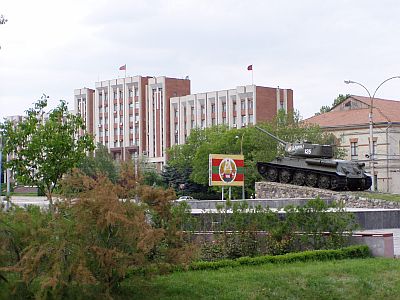
| |
Tiraspol: Supreme Soviet and War Memorial
|
In 1990, numerous polls took place in Transdniestr. Around 96% of the voters (with a turnout of 79%)
decided for the partition of the country. Not only the inhabitants of the area east of the Dniestr but also the
citizens of →Bendery were polled. The Supreme Soviet of Moldova declared
the poll void, whereupon Transdniestran representatives left the Soviet. Soon they declared the foundation of the
Transdniestran-Moldovan Soviet Socialist Republic (TDMSSR) as an autonoumous
republic as a part of the USSR. Later, the 'Soviet-Socialist' was erased. Thus, the name became
TDMR. It should be mentioned that not all Transdniestran representatives
voted for independence. Of course, the Supreme Soviet of Moldova ignored the decision. The TDMR
made the biggest town on it's territory, →Tiraspol, its capital and started
to build up selffence forces. Additionally, the 14th Russian Army, based in and around Tiraspol, was about to
play a decisive factor in the forthcoming conflict.
The first incident took place in November 1990. Protesting women occupied administration buildings in Dubăsari.
The protesters were removed violently and three people shot. Within the same month, another poll took place.
Now, 98% of the voters acknowledged the foundation of the TDMR. The breakaway republic continued establishing
its own police forces and army. Gradually, the Moldovan executive was driven out the country - partially with the use
of force. The situation escalated in 1992 when the smouldering conflict developed into a full-scale war.
In March, Moldova imposed martial law on the entire country. Many of the weapons used in the conflict
came from the 14th Russian army, which was accused of supporting the TDMR. Fights broke out in
→Bendery on the west bank of the Dniestr. The Moldovan police were
attacked and called Chisinau for help. Moldovan troops took the city on the 20 June 1992, but
paramilitary forces remained in parts of the city. After several attacks and heavy street fights,
Transdniestran forces managed to recapture the town on 26 June. One reason for the success of
the Transdniestrans was probably the fact, that the Moldovan forces, although employing heavy artillery and
jet fighters, hadn't manage to destroy the one and only bridge over the Dniestr in the area.
Sporadic fights broke out in Dubăsari as well. There's no reliable figure regarding the victims,
but an estimated 500 to 1,000 people were killed during the short war.
After calling a truce, the 14th army remained in the country (Transdniestr only) in order to provide stability.
However, in 2004 we got the impression that the army has left - all the large barracks we've seen in Tiraspol were
empty or used by Transdniestran forces. Still, some Russian peacekeeping forces remain in the country
(see →picture). In 1995, Transdniestr passed its own constitution.
According to the PMR constitution, freedom of speech and religion are guaranteed. The president is
elected every five years (practically, Igor Smirnov is the president since 1991 without
interruption). The president is also the head of the Soviet. There are wild speculations over Transdniestr,
partially spread by Moldova and the Western press. Rumours say that Transdniestr is a mafia infested place full of
corruption, human trafficking, road banditry and that Transdnistran scientists would have supported the Iraq and
provided military aid for South Ossetia and so on and so forth. Things like these are hard to (dis)prove, since the PMR
is internationally not recognized and therefore there's a lack of monitoring. However,
it's widely accepted that nepotism seems to be a serious problem. Internationally not recognized is only
half truth. The sovereignty of Transdniestr is recognized by other non-recognized countries only such as Abkhazia
(a secessionist republic in →Georgia) or
Nagorny Karabakh (an Armenian exclave in Azerbaijan, occupied by →Armenia.
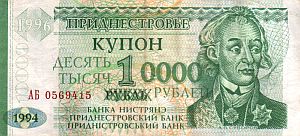
|
The galloping inflation in the 1990ies
produced weird banknotes
|
Although the country is heavily industrialized, the economic situation is very bad and the country is just dirt poor.
According to various sources, the average monthly wage is € 30 only. After a decade or so of runaway inflation,
the financial stability seemed to have stabilized. Poverty is omnipresent - even in the capital next to the
presidential palace. Some enterprises appear to be quite successful - among them a steel mill, the company
Sheriff (a printing company!?), which is recently erecting a brand new stadium for the
local soccer team and Kvint - a well-known cognac producer (throughout the CIS) and others.
The export volume of industrial products of Transdniestr is higher than the export volume of the Republic of Moldova.
Transdniestr declares that it has signed export contracts with around 50 different countries.
The future is absolutely unclear. Recent surveys show that almost all citizens of Transdniestr are not willing to
return to Moldova. Why should they? The economic situation in Moldova is not much better.
Fortunately, neither Moldova nor Transdniestr have the financial resources to start another bloody war.
But will Transdniestr ever be recognized by other countries? The leaders of the PMR are still in hopes of a revival
of the Soviet Union. I've seen new passports from PMR citizens with CCCP (Cyrillic for USSR) written on them.
Maybe Transdniestr should form a union with →Belarus -
it would be some sort of a communist dream team
|
|
|
|
|
|
|
Visa:
Since Transdniestr is not internationally recognized, there are no embassies and therefore no visa.
Upon arrival at the border post, everyone must leave the bus/car and has to collect two 'talons' (small pieces of paper).
One is for foreigners only and costs 5 USD, alternatively € 5 (although I'm really not sure whether this was a bribe -
but we received a proper talon for that). Another one is available in a separate building, where everyone (incl Moldovans) needs
to register. The fee is the same for every nationality - 6 Lei (€ 0.4). The passport won't be stamped, which is probably
better. It's important to keep the talons, or else it might become difficult to leave the country.
Restrictions:
It's possible to move around freely in Transdniestr. The old rule that everyone staying longer than 3 hours in the country must
register with the police is not valid any longer. However, it's still necessary to register when you stay overnight.
In that case, you will have to register with OVIR (the infamous police visa office) in the capital →Tiraspol.
As far as I've heard, hotels won't do that for you - without the correct paperwork you will be turned down by hotel staff.
In some areas, namely in →Bendery, there's still a curfew. Common sense but
yet worth mentioning: it's strictly forbidden to photograph strategically important objects such as army-related infrastructure,
industrial facilities and so on. Attention: It's definitely wise to check the latest news about Transdniestr.
The country itself is quite safe and most people are very friendly, but the political situation may tilt in the blink of an eye.
Money:
Transdniestr issues its own money. After years of galloping inflation, which even overloaded the money press, the national bank introduced
new money in the year 2000.
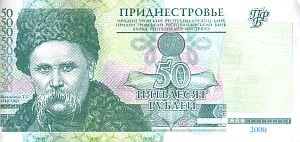
| |
The new PMR-Rouble
|
Costs: Prices in Transdniestr are, well, communist. There aren't any ritzy
restaurants or shops - at least I didn't see one. In canteens, you can have lunch for € 1 for two persons.
Of course you shouldn't expect culinary delights. Public transport is extremely cheap, too.
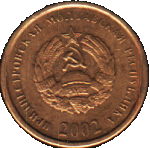
| |
Back to the USSR!
|
Getting there:
By bus or train. All trains from →Bucharest and →Chişinău
to →Kyiv (Kiev) as well as all trains from →Chişinău to
→Odesa stop in →Bendery and →Tiraspol.
There are many border crossings to the →Ukraine, but the most convenient and important
one lies in the south-east near Первомайск (Pervomaisc).
According to various reports, crossing the Ukrainian-Transdniestran border can become an expensive pleasure for travelers since bribes are common.
Several daily buses run from →Chişinău, →Comrat and other
destinations in Moldova to Transdniestr. Most of them cross the border near Bendery. From Chisinau to →Bendery
it takes around one hour, to →Tiraspol almost two hours. The fare is 14 Lei (€ 1) to Tiraspol and from Bendery to
Chisinau 7 Roubles (€ 0.8).
Getting around:
Since there aren't any railway tracks north of Bendery and Tiraspol, it's only possible to get around
on buses and marshrutkas (minibuses). There are also trolleybuses connecting
→Bendery and →Tiraspol, a ticket
costs 0.7 Roubles to be paid on the bus. Occassionally there are also some taxis.
Food & drinks:
McDonalds and Co haven't taken over yet. Actually there aren't many restaurants around, but at
least there are some in Tiraspol and least one café in Bendery. We've even spotted a pizzera in Tiraspol. More common than
restaurants are old-fashioned canteen-like places, all of them self-service of course.
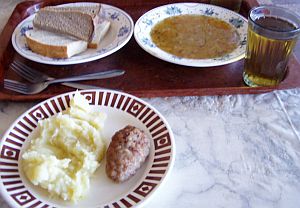
| |
Typical canteen food: Sorry, sauce is sold out
|
Transdniestr even produces its own beer - the local brand is called
Старая Крепость (Staraya Krepost', Old Fortress)
but cannot really recommended. Many other drinks as well as processed food are imported from neighbouring
→Ukraine. The genuine Transdniestran company
Kvint with it's modern headquarters in Tiraspol produces drinkable wine and fine brandy.
The Transdniestran cognac is definitely not as good as the Armenian cognac (uh, I love it...), but it's still worth giving it a try.
Kvint-Cognac is one of the famous export articles - especially in Russia and other CIS countries. In Transdniestr, a 10-years old
Kvint will set you back around € 4. In Moldova, the price already doubles.
|
|
|
|
|
|
|
bhhrg.org/CountryReport.asp
Report about the recent situation in
Transdniestr from the OSCE (Organization for Security and Cooperation in Europe).
I strongly recommend to read it before going there!
www.memo.ru/hr/hotpoints/moldavia
English essay about the war in Bendery etc.
www.custom.tiraspol.net/eng
English version of the PMR constitution
www.cbpmr.net
Official website of the Bank of Transdniestr, containing useful information. Russian, German and English.
www.mfa-pmr.idknet.com
Official website of the Foreign Ministry of Transdniestr. English version available.
Do you have or do you know a good website on Transdniestr/ the PMR? Don't hesitate, let me know!
After checking it, I would love to add it to the link list.
Please note that commercial websites will be declined. For e-mail link see menu on the left.
|
|
| |